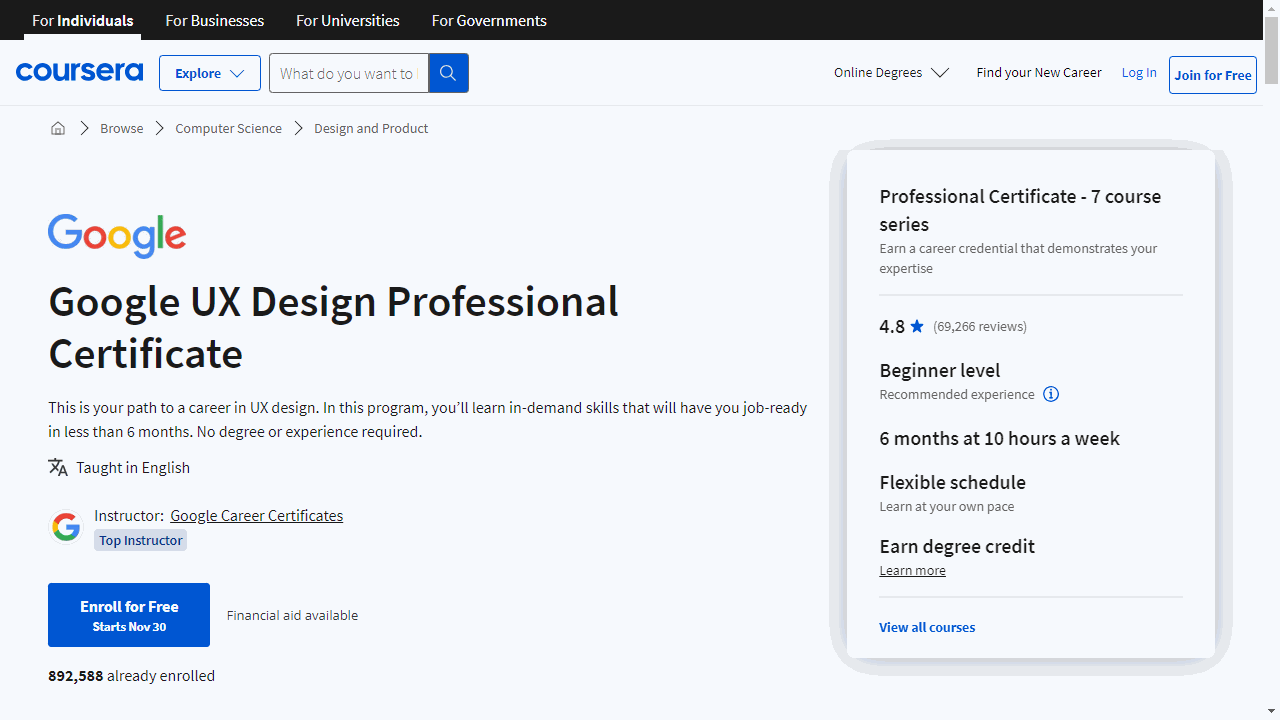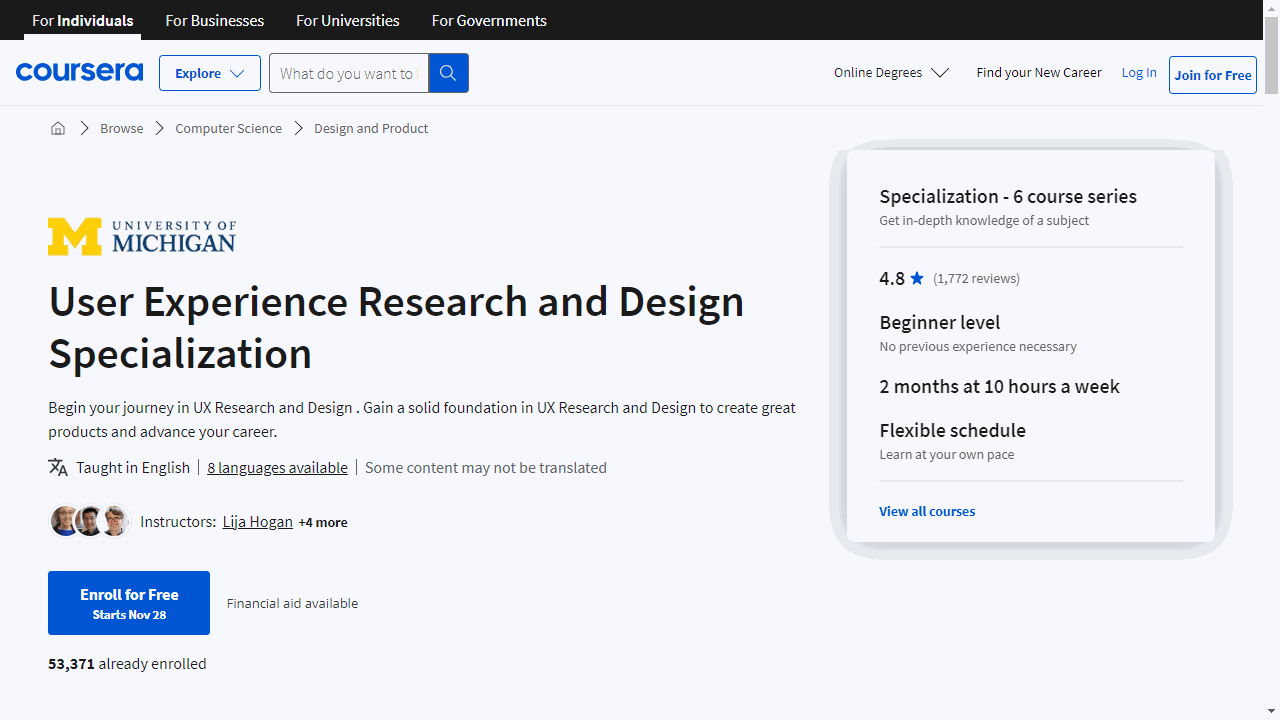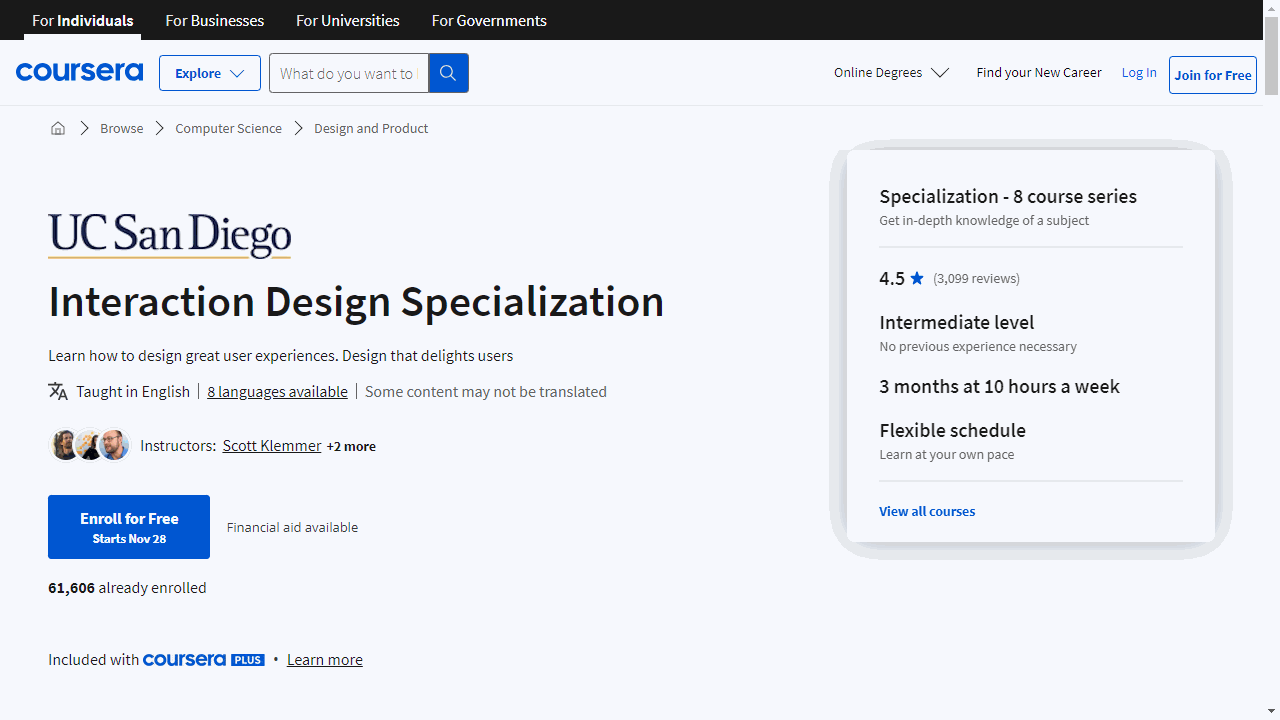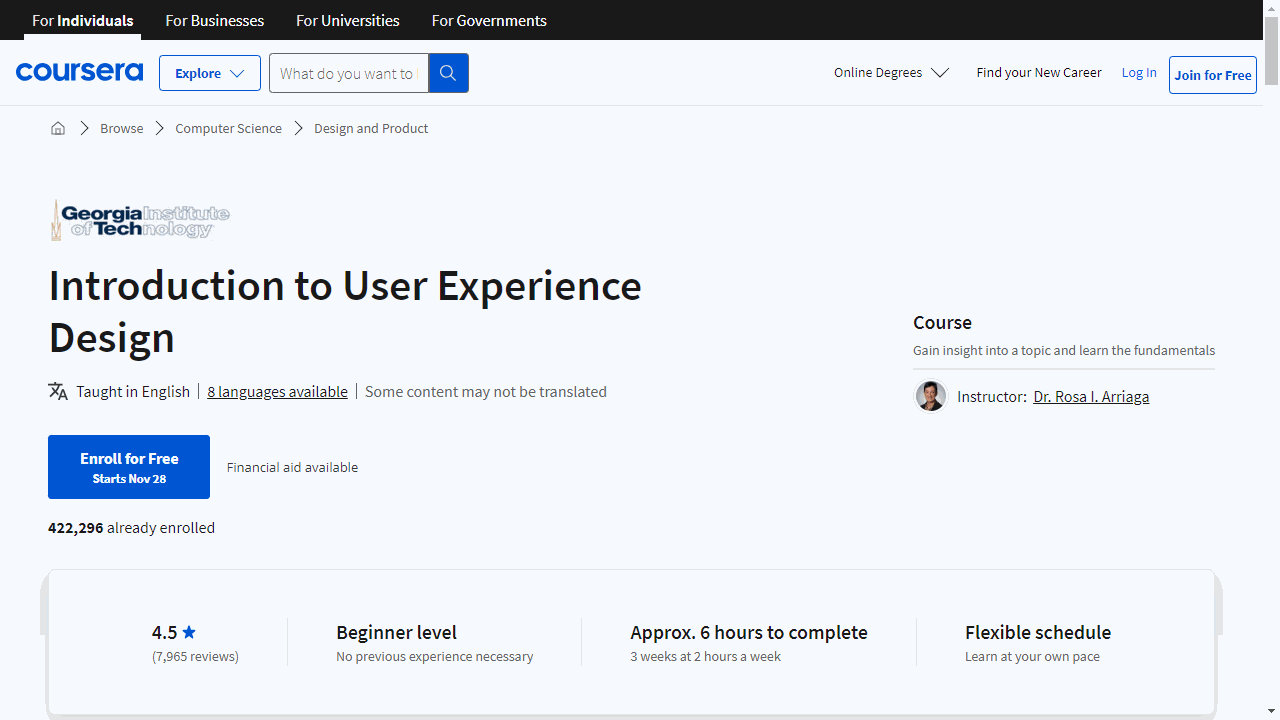User experience (UX) design is the art and science of crafting digital products and services that are user-friendly, enjoyable, and meet the needs of the user.
It’s an essential skill in today’s digital world, as businesses strive to create products that resonate with their target audience and drive customer satisfaction.
Learning UX design can open doors to exciting career opportunities in the tech industry and beyond, allowing you to shape the digital experiences that people interact with every day.
Finding the right UX design course on Coursera can be a daunting task, with so many options available.
You’re looking for a program that’s comprehensive, engaging, and taught by experts, but also fits your learning style and goals.
For the best UX design course overall on Coursera, we recommend the Google UX Design Professional Certificate.
This program is a comprehensive seven-course journey that equips you with the skills needed to apply for entry-level roles as a UX designer.
The certificate is created and taught by Google UX professionals, ensuring you learn from industry experts and gain valuable insights into the Google design philosophy.
While this is our top pick, there are other great options available on Coursera.
Keep reading to discover more recommendations tailored to different learning levels, career goals, and specific areas of UX design, such as UI design, interaction design, and user research.
Google UX Design Professional Certificate
This program is tailored to equip you with the skills necessary for entry-level UX design positions, and it does so with a practical, hands-on approach that’s grounded in real-world application.
The initial course, “Foundations of User Experience (UX) Design,” lays the groundwork.
It’s not just about learning the terminology; it’s about understanding the significance of UX design in the broader context of user satisfaction and business success.
You’ll delve into user-centered design, accessibility, and equity-focused design—key concepts that form the backbone of a UX designer’s role.
As you progress to “Start the UX Design Process: Empathize, Define, and Ideate,” you’ll begin to see through the eyes of the user.
This course emphasizes empathy, a critical skill for any designer.
You’ll learn to identify user needs and brainstorm creative solutions, setting the stage for your portfolio project.
In “Build Wireframes and Low-Fidelity Prototypes,” the focus shifts to visualization.
Here, you’ll sketch out your ideas and use tools like Figma to create wireframes, translating abstract concepts into tangible designs.
This step is crucial as it bridges the gap between what users need and the final product they’ll interact with.
“Conduct UX Research and Test Early Concepts” teaches you to validate your designs through user feedback.
This course reinforces the idea that good design is not just about aesthetics but also about functionality and user satisfaction.
You’ll learn to conduct research studies, analyze data, and refine your designs based on real user input.
With “Create High-Fidelity Designs and Prototypes in Figma,” your designs gain polish and interactivity.
This course is where your prototypes start to mirror a finished product, allowing you to test and iterate with a high level of detail.
The sixth course, “Build Dynamic User Interfaces (UI) for Websites,” expands your skill set to the web.
You’ll apply design principles to create responsive websites, learning about information architecture and common web layouts.
This course also offers guidance on job preparation, from crafting a resume to building a professional portfolio website.
Finally, “Design a User Experience for Social Good & Prepare for Jobs” brings your learning full circle.
You’ll undertake a comprehensive project with a focus on social impact, demonstrating your ability to create meaningful and user-friendly designs.
Additionally, this course prepares you for the job market, offering interview advice and insights into the world of freelance design.
The courses are designed to simulate the UX design process, with Google’s own UX designers and researchers as your mentors.
And with no prior experience required, the program is accessible to anyone with a passion for design and a willingness to learn.
UI / UX Design Specialization
Whether you have a background in graphic design, web development, or human-computer interaction, this specialization is designed to sharpen your skills and expand your understanding of UI/UX principles.
The journey begins with “Visual Elements of User Interface Design,” where you’ll master the fundamentals of crafting intuitive interfaces.
You’ll explore how to effectively use color, type, and imagery to communicate clearly through design.
This foundational course equips you with the skills to create a static interface that’s both functional and visually appealing.
Building on that foundation, “UX Design Fundamentals” takes you deeper into the design process.
Here, you’ll learn to transform your ideas into user-centric digital products.
The course guides you through ideation, sitemapping, and prototyping, culminating in the creation of your own app prototype.
It’s a hands-on experience that introduces you to industry-standard tools like Adobe XD and InVision.
In “Web Design: Strategy and Information Architecture,” the focus shifts to the strategic aspects of UX design.
You’ll delve into research, content structuring, and interactive sequences, all crucial for responsive web design.
This course also provides insights into the web design industry, different methodologies, and user testing, setting you up to plan sophisticated web projects.
The final course, “Web Design: Wireframes to Prototypes,” bridges the gap between theory and application.
You’ll bring your UX research to life through wireframes, mockups, and prototypes, learning about responsive web design, mobile-first strategies, and web typography.
This course also touches on the basics of web technologies like HTML and CSS, giving you a well-rounded skill set.
Throughout the specialization, you’ll gain proficiency in tools such as Adobe Illustrator, Balsamiq, and Sketch, preparing you for real-world UI/UX challenges.
User Interface Design Specialization
The specialization kicks off with “Introduction to UI Design,” where you’ll grasp the significance of user interface design and the foundational methods and theories behind today’s most intuitive interfaces.
Real-world case studies will highlight the stark contrast between good and poor design, emphasizing the importance of thoughtful UI creation.
In “User Research and Design,” you’ll dive into user research techniques to uncover what users truly need, crafting personas and scenarios that inform your design process.
This course empowers you to generate design ideas rooted in actual user data, ensuring your concepts are user-centric from the start.
“Prototyping and Design” shifts your focus to the tangible aspects of UI design.
You’ll practice prototyping with simple materials to visualize your ideas quickly and learn graphic design principles to enhance the visual appeal and functionality of your interfaces.
Accessibility design principles are also covered, ensuring your designs are inclusive.
Lastly, “Evaluating User Interfaces” rounds out the specialization by teaching you how to critically assess your designs.
You’ll learn both solo and team-based evaluation techniques, including usability testing, to refine your interfaces and set clear usability goals.
User Experience Research and Design Specialization
Starting with “Introduction to User Experience Principles and Processes,” you’ll get a solid grounding in UX research and design.
This course emphasizes the importance of iterative learning, equipping you with the ability to conduct user interviews, analyze design principles, and create prototypes that evolve based on user feedback.
In “Understanding User Needs,” the focus shifts to qualitative research methods.
You’ll learn to conduct semi-structured interviews and observations, using tools like affinity walls to distill user data into actionable insights.
This course is crucial for grasping the nuances of user behavior and translating them into design requirements.
“Evaluating Designs with Users” teaches you to validate your designs through user testing.
You’ll discover various testing methods, design effective tests, and learn to interpret the results to refine your designs.
This course is about ensuring your designs resonate with users and meet their needs effectively.
“UX Design: From Concept to Prototype” is where creativity meets practicality.
You’ll learn to define design problems, create user stories, and transform these into visual designs and prototypes.
This hands-on course is all about bringing your UX concepts to life and preparing them for real-world application.
For those interested in data-driven design, “UX Research at Scale: Surveys, Analytics, Online Testing” offers insights into gathering user feedback on a larger scale.
You’ll explore web analytics, A/B testing, and remote testing to understand user attitudes and behaviors across a broader audience.
Lastly, the “UX (User Experience) Capstone” allows you to apply everything you’ve learned in a comprehensive project.
From conducting research to designing and testing a product, this capstone project is your opportunity to demonstrate your UX expertise in a practical setting.
Each course is rich with relevant skills, from user research and human-computer interaction to prototyping and analytics.
Interaction Design Specialization
The specialization kicks off with “Human-Centered Design: an Introduction,” where you’ll master the art of crafting technology that delights users.
You’ll learn rapid prototyping, user research, and how to gather actionable feedback, equipping you with strategies to innovate across various domains.
In “Design Principles: an Introduction,” you’ll unravel the mysteries of intuitive interfaces.
This course demystifies visual design, perception, and cognition, empowering you to create interfaces that are not only functional but also naturally align with user expectations.
The “Social Computing” course explores the dynamics of online communities and the unique challenges of digital collaboration.
It’s a deep dive into leveraging technology to foster connections that transcend physical boundaries.
“Input and Interaction” focuses on the human aspect of interaction design.
Understanding the fundamentals of how people interact with technology allows you to craft interfaces that are responsive and intuitive, whether they’re for traditional screens or emerging gestural inputs.
“User Experience: Research & Prototyping” is a hands-on exploration of the design process.
From conducting thorough design research to transforming observations into innovative designs, this course is about turning insights into experiences that resonate with users.
“Information Design” teaches you to communicate ideas visually.
It covers essential design elements like typography and layout, ensuring your interfaces are as visually compelling as they are functional, adaptable to a range of devices and contexts.
“Designing, Running, and Analyzing Experiments” is where your designs meet the rigor of empirical testing.
You’ll learn to validate your UX decisions with data, using R for statistical analysis, a skill that bolsters the credibility of your design solutions.
The capstone of the specialization, “Interaction Design Capstone Project,” challenges you to apply your cumulative skills to a real-world problem.
This project is not just an academic exercise; it’s a portfolio piece that demonstrates your ability to navigate the full design process, from ideation to execution.
Design Thinking Specialization
Starting with “Design Thinking: Insights to Inspiration,” you’ll learn to identify and research human needs, setting the foundation for effective solution development.
This course emphasizes strategic thinking and innovation, guiding you through the initial stages of the design thinking process.
Moving on to “Design Thinking: Ideas to Action,” you’ll transform your insights into tangible concepts.
This course focuses on ideation and experimentation, teaching you to refine and test your ideas to ensure they resonate with users.
In “Design Thinking: Discovery Tools,” you’ll master essential tools for understanding your audience, such as stakeholder and journey mapping, personas, and ethnographic interviews.
This practical knowledge is crucial for creating designs that truly connect with users.
Lastly, “Experiencing Design: Deepening Your Design Thinking Practice” immerses you in the transformative aspects of design thinking.
You’ll explore six phases of the design journey and develop a Personal Development Plan to track your growth, gaining insights from industry leaders along the way.
Each course in this specialization, crafted by experts at the Darden School of Business, is designed to build upon the last, ensuring a well-rounded education in design thinking.
Introduction to User Experience Design
This course is very well-structured, guiding you from UX fundamentals to advanced concepts without overwhelming you.
The core of the program is the 4 Step Design Process, a practical framework that you’ll learn to apply to real-world projects.
This hands-on approach ensures that the skills you acquire are immediately applicable, enhancing your portfolio and professional value.
Clarity is a hallmark of this course, with outcomes that emphasize skill acquisition over mere theory.
Should questions arise, a comprehensive FAQs section is readily available to provide swift answers.
Beyond the basics, the syllabus includes a deep dive into essential UX terms and concepts, equipping you with the language and knowledge needed to thrive in the industry.
Ethical considerations in user engagement are also addressed, preparing you to design responsibly.
Understanding your audience is crucial, and the course covers various user types and data, employing discovery techniques like observation, surveys, and interviews to gather actionable insights.
Resources for requirement gathering and presenting task findings are provided, streamlining these critical steps.
Design iteration is another focus area, with lessons on creating alternatives and prototyping.
The course offers a wealth of resources and tools, ensuring you’re well-supported as you learn to evaluate and refine your designs.
Completing the course can lead to a Georgia Tech badge, certificate, or CEUs, adding a formal recognition to your newfound expertise.
Frequently Asked Questions
What is UX Design and why is it important?
UX Design, or User Experience Design, is the practice of designing digital products, applications, websites, and systems with a strong emphasis on the user’s experience, needs, and behavior.
It is crucial because it helps create products that are intuitive, efficient, and enjoyable for end-users, leading to increased user satisfaction, loyalty, and business success.
What are the different types of UX Design?
There are several types of UX Design, including user interface (UI) design, interaction design, information architecture, usability testing, and user research.
Each type focuses on different aspects of the user experience, from visual design and layout to navigation and user behavior.
What skills do you need to be good at UX Design?
Successful UX designers possess a diverse set of skills, including empathy, problem-solving abilities, creativity, analytical thinking, communication skills, and a solid understanding of design principles and user-centered methodologies.
They should also have a working knowledge of prototyping tools, usability testing techniques, and research methods.
What common tools should UX Design beginners learn?
UX Design beginners should familiarize themselves with industry-standard tools such as wireframing and prototyping software like Figma, Adobe XD, or InVision.
They should also learn user research tools like UserTesting or Hotjar, and develop proficiency in design software like Sketch or Adobe Illustrator.
What jobs can you get with UX Design skills?
With UX Design skills, you can pursue careers as UX Designers, UI Designers, Interaction Designers, Product Designers, UX Researchers, Information Architects, or Usability Analysts
These roles can be found in various industries, including technology, e-commerce, healthcare, finance, and more.
What should I look for in a UX Design course for beginners?
When choosing a UX Design course for beginners, look for a comprehensive curriculum that covers the fundamentals of user-centered design, design thinking methodologies, user research techniques, prototyping, and usability testing.
The course should also include hands-on projects and real-world case studies to provide practical experience.
What are the common uses of UX Design across various industries?
UX Design principles are widely applied across various industries to improve the user experience of digital products and services.
In e-commerce, UX Design ensures a seamless shopping experience; in healthcare, it enhances patient portals and medical applications; in finance, it streamlines online banking and investment platforms; and in education, it improves the usability of learning management systems and educational apps.







